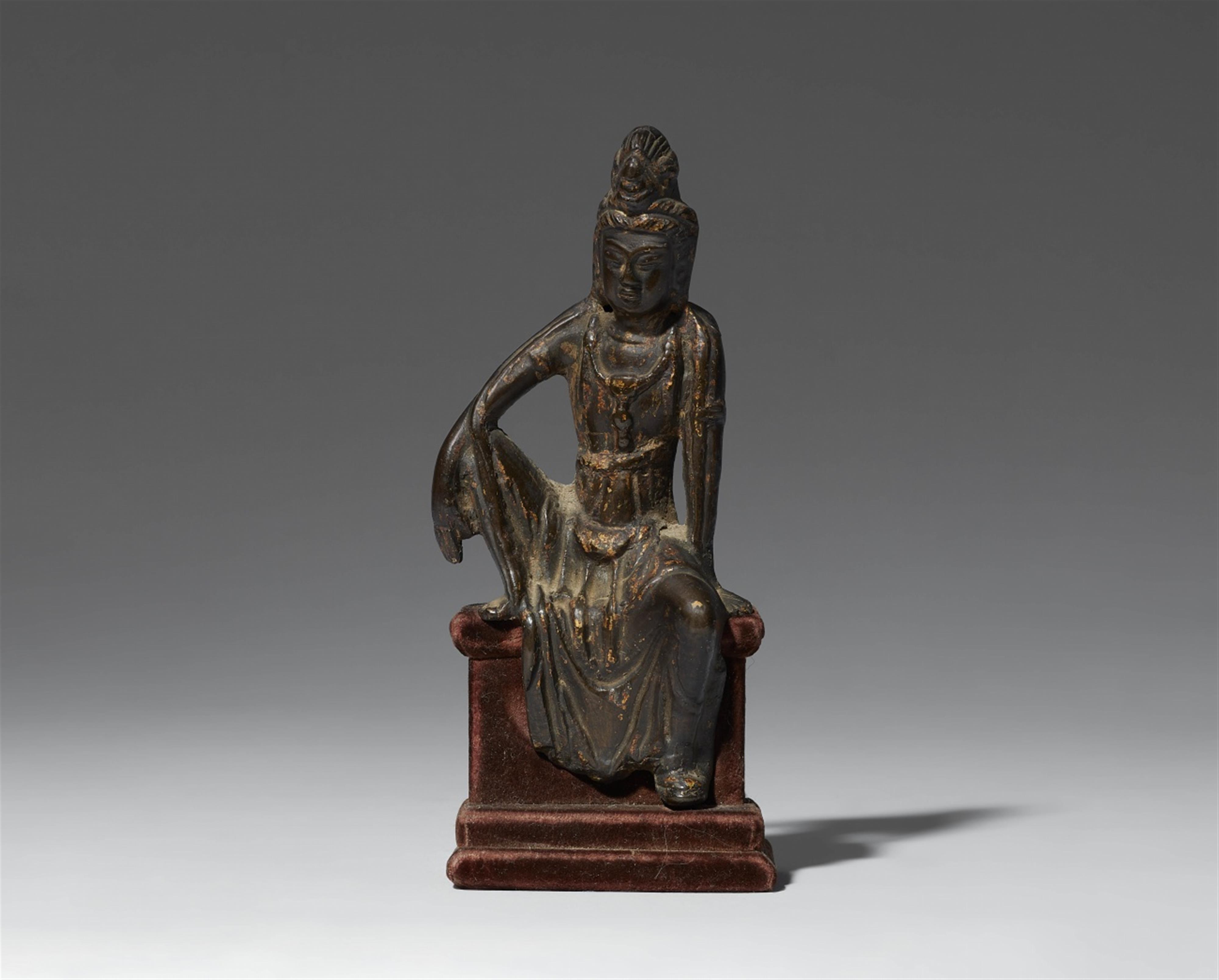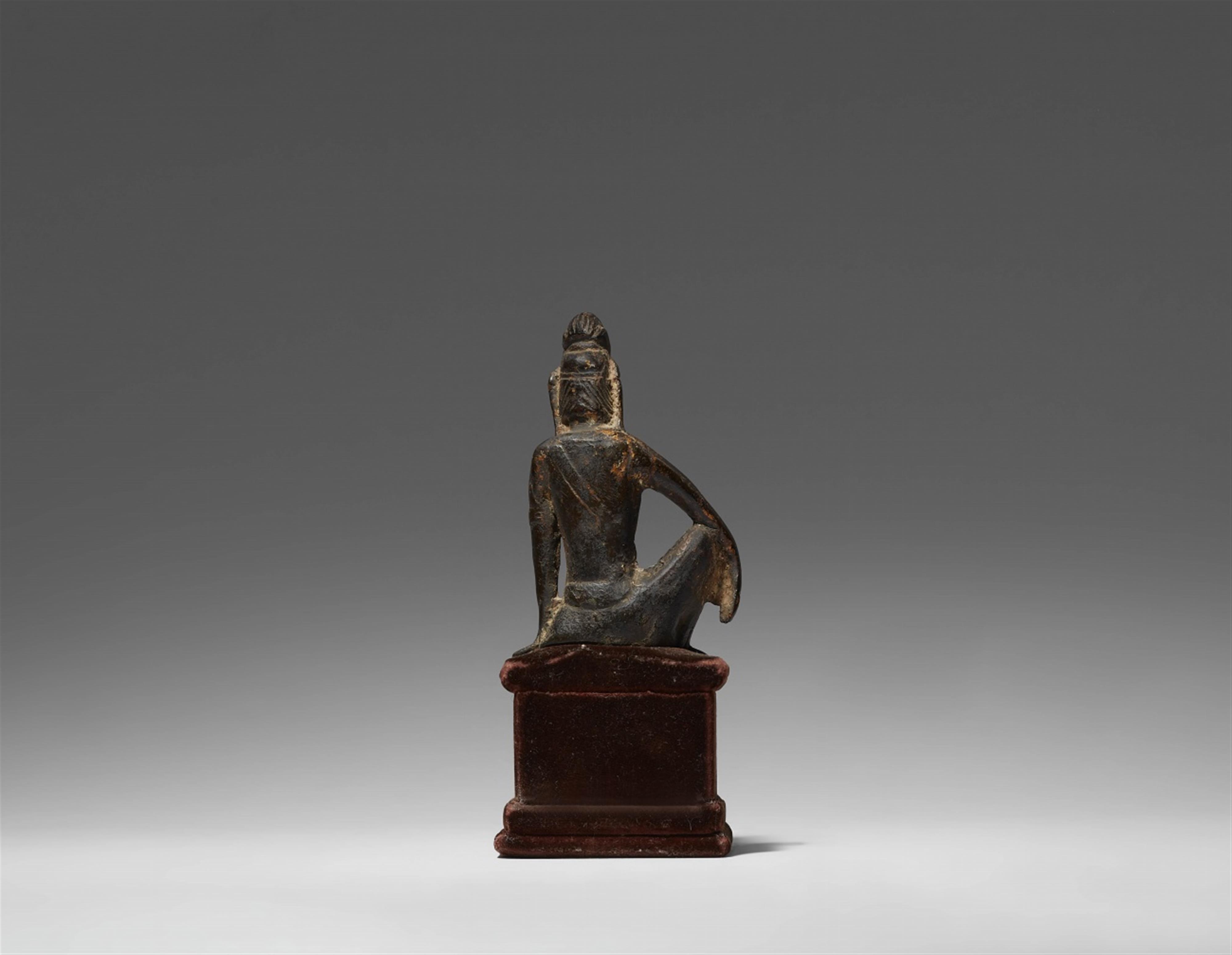A bronze figure of a Water-and-Moon Guanyin. Song dynasty, 11th/13th century
Seated in rajalila, the right arm resting on the knee, the chest displaying a necklace. The hair arrangend into a high chignon with a small Amitabha figure seated in front. Covered with a black lacquer patina with traces of lacquer gilding. On a stand covered with brown velvet.
Height with stand 14.3 cm
Representations of Avalokiteshvara seated in this variant fashion of rajalila in a natural surrounding are understood as references to the Water-Moon manifestation (Shuiyue Guanyin). The identification is based on the Avatamsaka Sutra, in which the boy Sudhana, in search for enlightenment, visits 53 wise teachers. The 28th teacher is Avalokiteshvara (chin. Guanyin), who resides on Mount Potalaka located on an island.
The image of Shuiyue Guanyin developed in China around the 10th century and quickly became one of the more prominent forms of this bodhisattva. In Chinese Buddhist paintings of the Song dynasty this manifestation of Avalokiteshvara is depicted seated at ease on a rock surrounded by water, obviously in allusion the mountain island. While large wooden sculptures of Shiyue Guanyin dating to the Song dynasty can nowadays be seen in many museums, the smaller bronze models such as the present example are less well known. The bronze adaptation of this subject usually comes in three assembled parts, a four-legged dais with rock-imitation platform, the seated figure with one leg flexed, the other pendant and an openwork aureole suggesting a grotto. Most of the bronze Shiyue Guanyin figures however have lost their base and aureole.
宋 銅水月觀音坐像(配木座)
此尊自在坐水月觀音是由《華嚴經》作為創作依據,背靠山石,由水環繞。
當時善財童子登上補怛洛迦山(這正是浙江普陀山山名的由來),參訪觀音菩薩:「見其西面巖谷之中,泉流縈映,樹林蓊鬱,香草柔軟,右旋布地,種種名華周遍嚴飾。觀自在菩薩於清淨金剛寶葉石上結跏趺坐,無量菩薩皆坐寶石恭敬圍遶,而為宣說智慧光明大慈悲法,令其攝受一切眾生。」(引自四十華嚴卷十六)
這個題材在10至14世紀的繪畫和造像中非常流行。如今可以在西方博物館中看到很多大的木製菩薩造像,這樣小的銅製觀音卻很少見。
可比:弗瑞爾藝廊,美國華盛頓特區,圖見於:H. Muensterberg 著,《Chinese Buddhist Bronzes》(中国青铜佛像),紐約1988年,圖69及故宮博物院歷代藝術館,北京1991年,頁293,第805號與德國科隆倫佩茨,2016年12月 8/9日,拍品編號222
Literature
The Freer Gallery in Washington, DC houses two similar Song dynasty bronze figures of Shuiyue Guanyin. The one illustrated in Hugo Munsterberg, Chinese Buddhist Bronzes, New York 1988 (Reprint), fig. 69, is covered with partly rubbed gilded lacquer, and the patina is very similar to the present figure. Kaikodo published a Shuiyue Guanyin in his Journal (2000, no. 72, p. 222-223 and 350), illustrating comparable figures in various Chinese collections. The figure in the Palace Museum Beijing is published in Gugong bowuyuan lidai yishuguan chenlienpin tumu, Beijing 1991, fig. 805, p. 293.
A comparable bronze figure of Shuiyue Guanyin was sold in these rooms 8/9.12.2016, lot 222.




